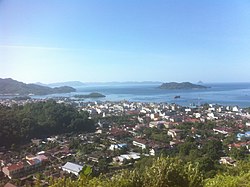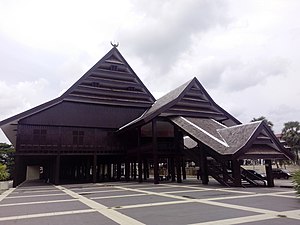Pusatoka: Difference between revisions
| Line 130: | Line 130: | ||
=Politics= | =Politics= | ||
==Municipal Government== | |||
===Mayor=== | |||
===City Council=== | |||
==Status as Municipality== | |||
Since the 1980s its regularly been proposed to change Pusatokas status from a municipality to a district. | |||
=Economy= | =Economy= | ||
==Transportation== | ==Transportation== | ||
Revision as of 19:16, 19 September 2023
This article is incomplete because it is pending further input from participants, or it is a work-in-progress by one author. Please comment on this article's talk page to share your input, comments and questions. Note: To contribute to this article, you may need to seek help from the author(s) of this page. |
Pusatoka
ᮕᮥᮞᮃᮊᮧᮒᮃ | |
|---|---|
 View on the city center of Pusatoka from the inner of Poeok | |
| Etymology: Foam City | |
| Special Municipality | Pusatoka Special Municipality |
| Founded by | King Gumelar II. of Batu |
| Government | |
| • Body | Pusatoka City Council |
| • Mayor | Botak Mainaky (Kapulakan People's Party) |
| Area | |
| • Total | 104.7 km2 (40.4 sq mi) |
| Elevation | 15 m (49 ft) |
| Population (2022) | |
| • Total | 109,437 |
| • Density | 1,000/km2 (2,700/sq mi) |
| Demonym | Pusatokan |
| Postal Code | 101 |
| Website | putasoka.gov.kl |
Pusatoka (Kapulakan:ᮕᮥᮞᮃᮊᮧᮒᮃ) is the oldest and largest city of Kapulaka and its capital. It was founded as a trade settlement during the Batu period and steadily grew since then. Pusatoka is both the political and economic centre of Kapulaka while simultaneously being home to roughly one third of Kapulakas population. Next to its function as national capital Pusatoka is also the capital of Poeok, the state it is located in. It's also the economic and cultural center of Kapulaka, housing the only International Airport in Kapulaka as well as the largest harbour. Almost every kapulakan company has their headquarters in Pasutoka and basically every international corporation operating in Kapulaka has a pressence in the city.
History
Early settlements
The history of settlements in the bay of Pusatoka probably traces back to the first humans to arrive on the Kapulakan Archipelago but volcanic activity up to the 13th century destroyed most of those early structures leaving only a very small archeological record. This same volcanic activity is also generally regarded as the one of the major factors for the construction of stilt houses by the kapulakans, a tradition that is kept alive to this day. Its generally assumed that by the time the Batu unified the islands under their rule Pusatoka already was the biggest settlement in the Archipelago.
Batu-period
After the first king of the Batu kingdom, King Gumelar I. already made Pusatoka his base of operations during the unification wars. As he died soon after having unified the different tribes it became the role of his son Gumelar II. to expand the settlement and finally make it his capital in 1215. Under the rule of Gumelar II. the town was expanded from being mostly located on stilts to also include land settlements, including temples and especially the Royal palace of Pusatoka.

Aguda-period
Colonial-period
Gaullican-occupation
In 1928 Cahya Sitepu created the Independent Pusatoka Fire Fighter Brigade.
Weranian-occupation
Modern period
Federation of the Corriveau-islands
August-coup
On the 20th of August 1964 the armed wing of the People's Freedom Front of Kapulaka(HRMK), the Republican Guard of Kapulaka stormed the government building in Pusatoka. After minor skirmishes with the National gendarmarie they entered the presidential office and arrested President Lotulelei. Afterwards the leader of the Republican Guard Ajat Sanaky was declared provisional president. The fighting between members of the Republican Guard and Lotulelei loyalists continued throughout Pusatoka for the next week until HRMK control of the entire city was secured. After the establishment of the modern kapulakan republic the first municipal elections in Pusatoka were held and Kusworo Rehatta sworn in as the first freely elected mayor of Pusatoka.
Politics
Municipal Government
Mayor
City Council
Status as Municipality
Since the 1980s its regularly been proposed to change Pusatokas status from a municipality to a district.
